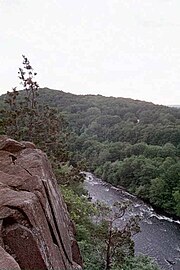Hatchet Hill
| Hatchet Hill | |
|---|---|

Tariffville Gorge from Hatchet Hill
|
|
| Highest point | |
| Elevation | 510 ft (160 m) |
| Parent peak | 41° 54' 20"N, 72° 45' 29"W |
| Coordinates | 41°56′15″N 72°44′53″W / 41.93750°N 72.74806°WCoordinates: 41°56′15″N 72°44′53″W / 41.93750°N 72.74806°W to 41°54′20″N 72°45′29″W / 41.90556°N 72.75806°W |
| Geography | |
| Location | East Granby, Connecticut |
| Parent range | Metacomet Ridge |
| Geology | |
| Age of rock | 200 Ma |
| Mountain type | Fault-block; igneous |
| Climbing | |
| Easiest route | Metacomet Trail |
Hatchet Hill, est. 510 feet (160 m), is a trap rock ridge located in East Granby, Connecticut, 11 miles (18 km) northeast of Hartford, Connecticut. It is part of the narrow, linear Metacomet Ridge that extends from Long Island Sound near New Haven, Connecticut, north through the Connecticut River Valley of Massachusetts to the Vermont border. The southern edge of the ridge plunges nearly 200 vertical feet (61 m) into the Tariffville Gorge. The ridge is known for its rugged topography, unique microclimate ecosystems, rare plant communities, and as a seasonal raptor migration path. It is traversed by the 51-mile (82 km) Metacomet Trail.
Roughly 2.5 miles (4.0 km) long by 0.75 miles (1.2 km) wide, Hatchet Hill is a collection of closely set tiered ridges and abrupt cliff faces with a high point of 510 feet (160 m). Its southern end is cut with steep cliffs at the Tariffville Gorge where the Farmington River gouges out a chasm between it and Talcott Mountain to the south. Also notable is Marsh Pond, a glacial kettle pond nestled in the center of the ridge. From Hatchet Hill, the Metacomet Ridge continues north as Peak Mountain and south as Talcott Mountain.
The northeast side of Hatchet Hill drains into the Connecticut River, thence to Long Island Sound; the rest of it into the Farmington River, thence to the Connecticut River.
Hatchet Hill, like much of the Metacomet Ridge, is composed of basalt, also called trap rock, a volcanic rock. The mountain formed near the end of the Triassic Period with the rifting apart of the North American continent from Africa and Eurasia. Lava welled up from the rift and solidified into sheets of strata hundreds of feet thick. Subsequent faulting and earthquake activity tilted the strata, creating the cliffs and ridgeline of Hatchet Hill. Hot, dry upper slopes, cool, moist ravines, and mineral-rich ledges of basalt talus produce a combination of microclimate ecosystems on the mountain that support plant and animal species uncommon in greater Connecticut. Hatchet Hill is also an important raptor migration path. (See Metacomet Ridge for more information on the geology and ecosystem of Hatchet Hill).
...
Wikipedia
